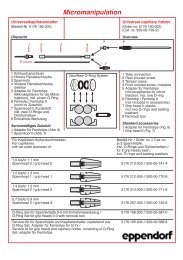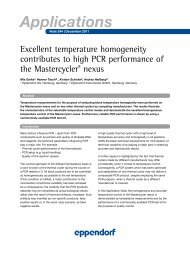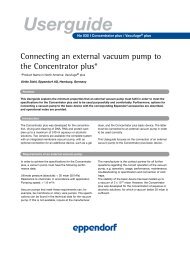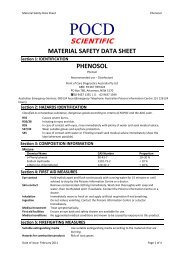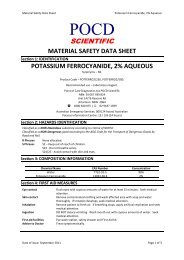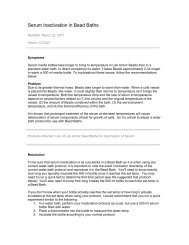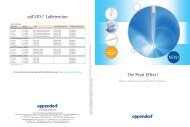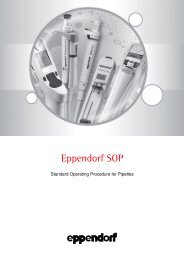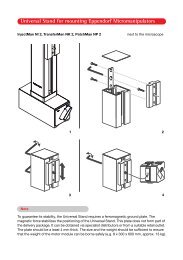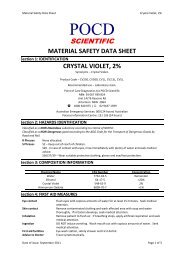Download - Eppendorf NA
Download - Eppendorf NA
Download - Eppendorf NA
You also want an ePaper? Increase the reach of your titles
YUMPU automatically turns print PDFs into web optimized ePapers that Google loves.
UserguideFemtoJet express | No 012/06Microinjection of plasmid D<strong>NA</strong> or doublestranded R<strong>NA</strong> into the gonads of C. elegansAuthor: Ryuji Minasaki, Max Planck Institute for Developmental Biology,Abteilung IV (Evolutionsbiologie), Tübingen, GermanyFIG. 1: Intragonadal injection in C. elegansIntroductionC. elegans was established as a model organism three decades ago by Sydney Brenner (Brenner 1974).Two major applications for microinjection in C. elegans are the production of transgenic worms (Mello et al.1991) and the knockdown of genes by R<strong>NA</strong> interference (Fire et al. 1998).Here, we describe a microinjection technique that has been established in our laboratory for these purposes.Applications for microinjection in C. elegans• Injection of D<strong>NA</strong> to generate transgenic lines• Injection of dsR<strong>NA</strong> to induce R<strong>NA</strong>i• Injection of proteinsResearch interestsTransgenic animals can be generated for a wide range of purposes. Some of the more popular uses are outlined below:• Direct transformation of mutant strains using cloned D<strong>NA</strong> by germline microinjection• Expression pattern analysis (e.g., GFP fusion constructs)• Structure/function analysis• Promoter Bashing• Identification of gain-of-function phenotype through overexpression / ectopic expression of an endogenousor foreign geneTable 1: Applications for microinjection in worm
Equipment• Inverted microscope (Axiovert ® 135, Carl Zeiss AG, Germany)• Micromanipulator TransferMan NK2 (<strong>Eppendorf</strong> AG, Germany)• Microinjector FemtoJet express, (<strong>Eppendorf</strong> AG, Germany)• Pipette puller (Sutter Instruments, Model P-87, USA)• Vacuum drying chambers (Binder, Germany)• Research Pipette (0,5 – 10 µl, <strong>Eppendorf</strong> AG, Germany)Materials• Agarose (VWR International)• Voltalef oil (VWR International)• Micropipette glass tubes; 100 mm long, 1.2 mm diameter (World Precision Instruments, Inc., USA)• Cover slips; 48 mm x 60 mm, 1 mm thick (Menzel Glaeser, Germany)• Microloader 20 µl (<strong>Eppendorf</strong> AG, Germany)MethodsPreparation of agarose padPlace a 2% agarose drop (60°C) on the center of a cover slip and gently sandwich by dropping another cover slip ontop. This flattens the agarose into a thin pad. Air bubbles should be avoided. It is more useful to have a large agarosepad because more worms can be mounted per pad. Remove one of the cover slips and air dry the pad overnight. On thenext day, bake the pad in the vacuum drying chambers for 2 - 4 hours before use. It is important to use dry agar padsotherwise the worms will not stick to the pad. Store the agarose pads in an air-tight container, preferably in a desiccator.Preparation of injection pipettes and loading the injection mixtureInjection pipettes are produced using a mechanical pipette puller. The needle-pulling parameters (heat, pull, velocity andtime) are adjusted in a “trial-and-error” manner. Good needles taper quickly to a sharp-open point, although each usermay develop unique preferences. The shape of the tip may change depending on the position of the heating filament. Ifthe needle is produced with a closed tip, the tip has to be broken prior to microinjection.The injection mixture is loaded into the injection pipette by a very long and thin Microloader pipette tip inserted throughthe wide back-end.Mounting and breaking the tipAssemble the injection capillary to the handle of the micromanipulator. The capillary holder is connected to a FemtoJetexpress microinjector, which is attached to a pressurized nitrogen supply. Place a glass tube on a cover slip and coverthe glass tube completely with Voltalef oil. Transfer this cover slip to the Zeiss Axiovert 135 inverted microscope. Alignthe glass tube perpendicular to the angle of the capillary. Center the glass tube and the needle tip in the field at lowmagnification (e.g., 40x). Be careful to let the tip of the capillary neither touch the glass tube nor the surface of the coverslip. Change to a higher magnification (e.g., 100x). Break the tip by gently pressing the tip against the glass tube. Pleasekeep in mind that if the breakage is clearly visible, the capillary will not be sharp enough for successful injections.Mounting the worms on an agarose padPlace a drop of Voltalef oil on the agarose pad. Pick a worm and let it swim in the oil to get rid of residual OP50 culture(OP50 is an E. coli strain fed to C. elegans). Transfer the worm with plenty of oil to the pad. Attach the worm carefully tothe surface of the pad with a pick or tweezers. Straighten the worm and align it perpendicular to the injection needle.Getting the animal to stick to the pad can be a challenge: If the pad is not freshly vacuum dried, it is difficult to attachthe worm.
InjectionThe parameters (injection pressure (Pi), compensation pressure (Pc), injection time (Ti)) of the FemtoJet express microinjectorshould be adjusted according to the quality of the needle and how the needle is broken. There aren´t any fixedparameters for injection pressure nor for the duration of injection.The FemtoJet express offers an "automatic" and a "manual" injection mode. The injection is triggered by hand controlor an optional foot control. "Automatic" means that the duration of injection is preset on the device by defining the injectiontime (Ti). In the "Manual" mode the injection time is determined individually, which means that injection proceeds aslong as the foot or hand control is triggered. In our laboratory we use this mode as injection is performed until someliquid can be seen in the gonads.Inject into the mitotic region of the worm gonad by gently pushing the microscope stage (the worm is moving accordingly)towards the needle and carefully move the micromanipulator towards the worm. Inject the mixture by pressing theleft mouse button. The success of injection can be checked by observing whether the germ line cells are disturbed ornot. Pull out the capillary by moving the microscope stage away from the needle. It is essential to check whether or notthe needle tip is blocked. If the injection mixture does not flow out easily, press the right mouse button (Clean function)until the blockage is removed.Changing the capillaryIf the capillary keeps being blocked, the needle has to be changed. Be very careful: the pressure can cause the needleto shoot out like an arrow. To avoid this, always push the Menu button – "Option 0" – which will remove any pressure inthe needle.RecoveryBy gently touching the side of the worm with a picking rod, it will start to float in the oil. Remove the worm from the oiland place it to a OP50 culture. After one hour, transfer the worm to a new OP50 culture plate to remove residual oil.ReferencesBrenner, S., 1974 The genetics of Caenorhabditis elegans. Genetics 77: 71-94.Fire, A., S. Xu, M. K. Montgomery, S. A. Kostas, S. E. Driver et al., 1998 Potent and specific genetic interference bydouble-stranded R<strong>NA</strong> in Caenorhabditis elegans. Nature 391: 806-811.Mello, C. C., J. M. Kramer, D. Stinchcomb and V. AMBROS, 1991 Efficient gene transfer in C.elegans:extrachromosomal maintenance and integration of transforming sequences. Embo J 10: 3959-3970.Additional literatureEvans, Thomas C., Transformation and microinjection, WormBook, The C. elegans Research Community, WormBook,http://www.wormbook.org.Ordering information:ArticleDescriptionOrder no. internationalNorth AmericaFemtoJet expressTransferMan NK2InjectMan NI2PatchMan NP2MicroloaderResearch PipetteProgrammable microinjector with externalpressure supplyProportional micromanipulator for microinjectionDynamic micromanipulator for microinjection,can be combined with FemtoJet expressDynamic micromanipulator for microinjectionSpecial pipette tips for filling Femtotips fromthe rear0.5 – 10 µl5248 000.0175188 000.0125181 000.0175183 000.0145242 956.0033111 000.122920010521920000011920000029920000037930001007022471902AU 012 WW 020/PDF/0206/KW eppendorf® is a registered trademark●Your local distributor: www.eppendorf.com/worldwide Application · Support: E-Mail: support@eppendorf.com<strong>Eppendorf</strong> AG · Germany · Tel. +49 40 538 01-0 · E-Mail: eppendorf@eppendorf.com<strong>Eppendorf</strong> North America, Inc. · USA . Tel. +1 516 334 7500 · Toll free phone 800 645 3050 · E-Mail: info@eppendorf.com



